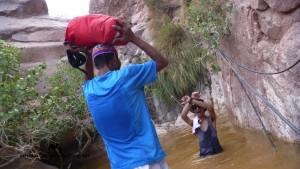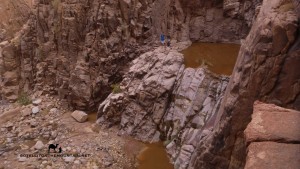August 19, 2015
Chasing the summer rain…
 A couple of days ago, I was sitting in a cafe in St Katherine, sipping a cup of tea when big, Biblical thunder began echoing around. I walked outside to see what was happening and saw dark thunderclouds gathering over Jebel Abbas Basha – one of the big mountains near the town – and then smelt the scent of rain, carrying in the breeze. Over Jebel Abbas Basha the clouds burst, the heavens opened and a deluge fell; soon, the water level rose and a flash flood went tearing down through Wadi Shagg, on the western side of the mountain. Then, down to more distant wadis. People who saw it – including a Bedouin guide who was in Wadi Shagg with two foreign hikers at the time – said it looked incredible; a huge, raging river of sand, boulders and dead shrubs.
A couple of days ago, I was sitting in a cafe in St Katherine, sipping a cup of tea when big, Biblical thunder began echoing around. I walked outside to see what was happening and saw dark thunderclouds gathering over Jebel Abbas Basha – one of the big mountains near the town – and then smelt the scent of rain, carrying in the breeze. Over Jebel Abbas Basha the clouds burst, the heavens opened and a deluge fell; soon, the water level rose and a flash flood went tearing down through Wadi Shagg, on the western side of the mountain. Then, down to more distant wadis. People who saw it – including a Bedouin guide who was in Wadi Shagg with two foreign hikers at the time – said it looked incredible; a huge, raging river of sand, boulders and dead shrubs.
The Bedouin call summer rain like this a sarookh – meaning ‘rocket’ – because unlike rain in winter, which usually comes from clouds that cover bigger areas – this comes from isolated clouds, hitting more specific spots.
The rain this summer was an absolute textbook example.
As the Bedouin name suggests this rain is often the most dangerous. First of all, because it comes so suddenly, with little warning. Secondly, because when it comes, it’s usually heavy, fast and violent; meaning the flash floods grow more quickly. If you get stuck in a wadi when a sarookh hits the best thing you can do is to climb the sides as quickly as you can. If you’re stuck in a narrow canyon whose sides you can’t climb, you can be in real trouble. In fact, you need to be vigilant all the time for this sort of rain through the hotter times of the year because although it might be beautiful weather where you are a sarookh might have hit a wadi upstream of you, sending a flood your way…
This time around, thankfully, everybody was OK in St Katherine. And also in settlements downstream, which the flood later tore past…
 This was my first time being near summer rain in the Sinai and I was annoyed to have not actually seen it. The next day I went to Wadi Shagg to see what it had left behind though. Everything looked beautiful. Red rockpools lay between the boulders, with small waterfalls between them. The sound of running creeks echoed around the sides of the wadi. The tracks of birds covered big, shining flats of mud – which were rippled like waves – as they dried slowly in the sun. Dead shrubs sat on top of boulders…
This was my first time being near summer rain in the Sinai and I was annoyed to have not actually seen it. The next day I went to Wadi Shagg to see what it had left behind though. Everything looked beautiful. Red rockpools lay between the boulders, with small waterfalls between them. The sound of running creeks echoed around the sides of the wadi. The tracks of birds covered big, shining flats of mud – which were rippled like waves – as they dried slowly in the sun. Dead shrubs sat on top of boulders…
It was the best I’ve seen Wadi Shagg looking and all the better because there had been no good rain here for at least a year. I went back to town to get a couple of friends. The three of us went on an adventure up the bottom of the wadi, wading through waist deep water and clambering up waterfalls – the perfect way to cool off in this most sweltering of sweltering summers. At the top of the wadi we found a huge pool – the biggest I’ve seen in the mountains near St Katherine – below a dripping tongue of sediments left behind by previous floods. We ate, swam and then followed the path of the flood back to St Katherine, passing Jebel Abbas Basha in the night, under a crescent moon.
 Quite apart from making these wadis look beautiful and giving brilliant canyoning-type adventures this rain is good news because the Sinai really needs it. Wells and springs are getting lower and everything is dry. Right now, in Wadi Shagg, tree roots are submerged in water and the animals have a place to drink. And it wasn’t just Wadi Shagg. Two other mountains – Jebel Tarbush and Jebel Serbal – also had rain. The Bedouin say more might be on the way this summer too. If you want to escape the heat of Cairo – or Dahab or Sharm – there’s nowhere better than Wadi Shagg. I reckon the waterfalls will stay a couple of days and bigger pools over a week. Just remember to look out for another flood. You never know, lightning might strike the same wadi twice…
Quite apart from making these wadis look beautiful and giving brilliant canyoning-type adventures this rain is good news because the Sinai really needs it. Wells and springs are getting lower and everything is dry. Right now, in Wadi Shagg, tree roots are submerged in water and the animals have a place to drink. And it wasn’t just Wadi Shagg. Two other mountains – Jebel Tarbush and Jebel Serbal – also had rain. The Bedouin say more might be on the way this summer too. If you want to escape the heat of Cairo – or Dahab or Sharm – there’s nowhere better than Wadi Shagg. I reckon the waterfalls will stay a couple of days and bigger pools over a week. Just remember to look out for another flood. You never know, lightning might strike the same wadi twice…